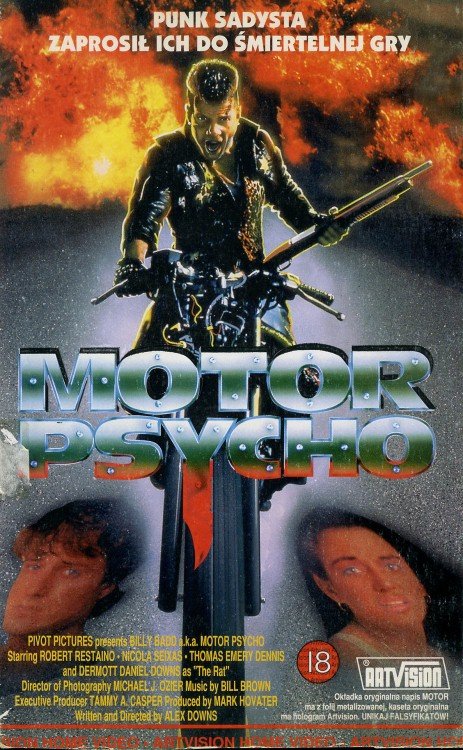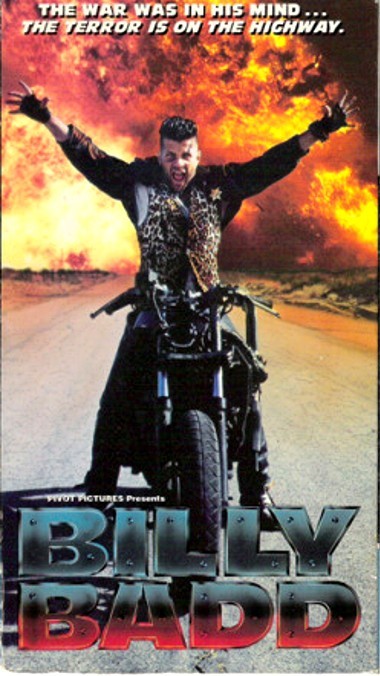A psycho stalking youngsters across the desert has been done to death – but, says Dave, never quite like this. Featuring a quick word with star Elvis Restaino!
Flame-haired Dermott Downs could be the poster boy for the term ‘all-rounder’.
A child actor who started working at the age of ten, Downs scored roles in a number of movies that are etched into everyone’s childhood – Escape to Witch Mountain (1975) and Freaky Friday (1976) to name but two. Alas, by the time Downs hit his twenties, the jobs began to dry up. He switched to grip work at the dawn of the ‘90s, serving on A Nightmare on Elm Street 5: The Dream Child (1989) and Leatherface: The Texas Chainsaw Massacre III (1990), and graduated to cinematography a few years later. Directing was the natural next step, and Downs has since become an integral part of The CW’s Arrowverse, lending his expertise to glossy superhero shows The Flash, Supergirl, and Legends of Tomorrow.
A little over thirty years ago, though, it was Downs’ brother, Alex, who seemed like he was going to be the director in the family.
Alex Downs wrote and directed MOTOR PSYCHO (1992) (aka ‘Billy Badd’).
It was his first and last credit.
A sole appearance on IMDb is always a head-scratcher – but Downs’ Mojave-set tailspin hits a level of crazy that makes his fleeting foray into filmmaking all the more understandable.
Zoey (Nicola Seixas) and Frankie (Thomas Emery Dennis) are two loved-up teens on their way to New York in a VW Campervan. They’re a raucous pair – think Mickey and Mallory sans rap sheet – with loose lips and looser clothes. However, their boisterous behaviour is curtailed when they come face to face with Billy Badd (Elvis Restaino): a leopard print waistcoat sporting lunatic. Equipped with a shotgun, his thighs astride a growling hog, Billy takes a fancy to them and sets about putting the youngsters through an ordeal of John Ryder-esque proportions.
Restaino’s film career was limited to a handful of films in the ‘90s before he went ‘legit’ and formed a design and renovation company. His redesign of Gerard Butler’s loft made the front cover of Architectural Digest. Quite why Restaino didn’t evolve into a cult icon in the wake of Motor Psycho is a mystery, because his take on Billy Badd is one of the most startling performances of the decade. And to think, he barely made it into the audition:
“It was so overwhelming,” recalls the actor turned designer. “At the audition I was surrounded by these tall handsome men. It was intimidating. I had a panic attack! I felt very insecure. I sat down on the curb and was crying. There was a thrift store in front of me with a mannequin in garters and lingerie. I was staring at it through the window and positioned myself so that my reflection was lined up with the form. I finally got my breath back.”
“At the audition I was on stage listening to Alex’s voice from the darkness. I didn’t know what Alex wanted in the character and I really had no idea who Billy Badd was besides a shotgun-toting psychopath on a motorcycle. I didn’t have a script to determine anything, just sides from a few scenes. Before I uttered a word I took all my clothes off and I was wearing the lingerie from the mannequin. I heard Alex laugh and the rest was a blur.”
Much of Restaino’s uninhibited performance succeeds, giving him a dynamic vibe akin to Nicolas Cage on steroids, but a little of it fails too, and he’s left looking like a scrubbed up Hells Angel after a rough night on Colombian party powder. All of it, however, is memorable – even if your enjoyment of the actual movie will depend on your tolerance for the star’s unique, erm, ‘style’.
Good support from Seixas and Dennis elevates Motor Psycho to taut three-hander status, and it would be remiss not to tip the hat towards Dermott Downs who briefly resurrects his acting career as a bandana wearing bum with a connection to Badd.
As for Restaino, Motor Psycho remains a part of his life that he wishes he could replay:
“When I look back, my only regret is not savouring it more. I committed hard to the character of Billy Badd. I was deep in all those moments but they were temporary. Nothing was connected, everything was disconnected. Caught in a whirlwind and then, poof, gone. Alex challenged me on every take.”
“Months later, I was at the film market in Santa Monica at the Lowes Hotel promoting the film dressed in character. That was the first time I saw the trailer and the first time I truly understood who Billy Badd was. I had such a desire to see the film and finally meet this nut job.“
“Later that same day, at the hotel bar, I was mingling with the buyers and yapping it up. Two beautiful girls approached and introduced themselves. I said, “Hello. I’m Billy Badd!” The look on their faces was intoxicating. Let me tell you, that entire night and early into the morning I was ‘Very Badd’! [laughs]”
Motor Psycho channels a host of influences, obvious and otherwise. From The Hitcher (1986) to Highway to Hell (1991), it’s a patchwork of every desert-based action/horror/thriller picture in existence – and yet it still oozes a ferocious and captivating originality. At times it’s a high-contrast sensory overload, but its flaws are forgivable due to the impudence with which it announces itself.
Props to the pull quote on the film’s U.S. video box.
“An over-the-top action-thriller with hyperkinetic edges” is the most definitive description of Downs’ one-and-done you’ll ever read.



